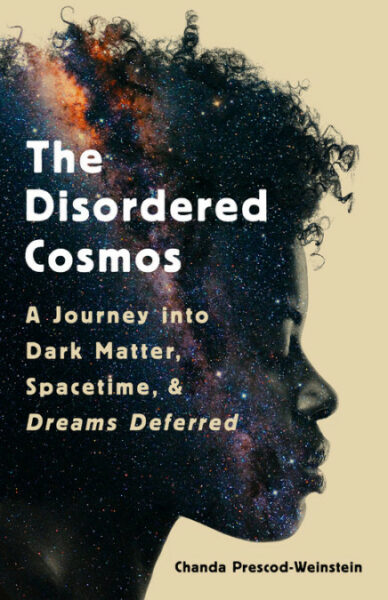The Freedom to Be Curious
A Review of Chanda Prescod-Weinstein’s The Disordered Cosmos
By Lisette E. Torres
Volume 24, Number 1, Racial Capitalism
June 30, 2021
 True to her online persona (and I assume her offline one as well), Dr. Chanda Prescod-Weinstein, Assistant Professor of Physics and Astronomy as well as a core faculty member in Women’s and Gender Studies at the University of New Hampshire, speaks truth to power in her new book, The Disordered Cosmos. As a fan of her work, I was thrilled that she published this powerful combination of personal story-telling and critical social analysis of physics and, more broadly, science. I was hoping that her sharp commentary and accessible examples would come through the narrative, and she did not disappoint! Honestly, as a woman of color who used to be a scientist, I have been waiting for a book like this for most of my adult life. Let’s just say that I recommend this book to anyone who is interested in equity in STEM. Her unique perspective as a Black agender woman makes this a must-read on physics and science culture. She makes marginalized scientists of color, like me, feel seen.
True to her online persona (and I assume her offline one as well), Dr. Chanda Prescod-Weinstein, Assistant Professor of Physics and Astronomy as well as a core faculty member in Women’s and Gender Studies at the University of New Hampshire, speaks truth to power in her new book, The Disordered Cosmos. As a fan of her work, I was thrilled that she published this powerful combination of personal story-telling and critical social analysis of physics and, more broadly, science. I was hoping that her sharp commentary and accessible examples would come through the narrative, and she did not disappoint! Honestly, as a woman of color who used to be a scientist, I have been waiting for a book like this for most of my adult life. Let’s just say that I recommend this book to anyone who is interested in equity in STEM. Her unique perspective as a Black agender woman makes this a must-read on physics and science culture. She makes marginalized scientists of color, like me, feel seen.
Prescod-Weinstein hooks the reader from the very beginning, as she starts the book with a short bedtime story of the creation of the universe, connecting baryogenesis (the process by which matter comes to dominate antimatter) with life on earth and the Black Lives Matter movement. She goes on to explain how she structured the book in relation to her intellectual understanding of her positionality within the world of physics. In her usual no-holds-barred approach, she writes honestly, “When you’re looking at the world from the margins, a persistent feeling of ‘the sublime’ can feel out of reach as you struggle against mundane and pervasive forces of oppression” (p. 6). Using phase transitions as a metaphor for her journey, she divides the book into four sections—Just Physics, Physics and the Chosen Few, The Trouble with Physicists, and All Our Galactic Relations—and each section has three to four chapters. In all, there are fourteen full chapters and a closing letter to her mother, along with recommended readings.
The first phase of the book is a blend of Prescod-Weinstein’s love of particle physics and the troubling language and history of the discipline. She shares the mathematical beauty of symmetry in the Standard Model, or the theory of how the building blocks of matter interact via three (out of four) fundamental forces, while also pointing out the problematic language around quantum chromodynamics (QCD), “a theory that uses color as an analogy for physical properties that have nothing to do with color” (p. 26). She explains that, according to QCD, each particle, like a quark and anti-quark, has a color charge that must cancel to form another particle with “neutral white charge” (p. 22). The fact is that the use of color has nothing to do with what happens to the particles; one could easily give these charges other names without altering the mathematics. Reflecting on the language use, Prescod-Weinstein astutely notes that ‘color’ and ‘white as neutral’ are not reflections of how the universe works, but rather how a homogeneous, white scientific community comes up with new names for stuff (p. 26). While she loves the elegance of the Standard Model and its associated components like QCD, she acknowledges and struggles with her complicity in its problematic history and language given that she uses the knowledge and language of a field shaped by White supremacy and colonialism.
Throughout Phase 1 of the book, Prescod-Weinstein explores this tension as she describes her professional work. In a chapter about dark matter, she explains the origin of the term dark matter and how it is not “dark.” While explaining the bending of spacetime around matter, she explores how one’s intuition about its nature is influenced by one’s race or ethnicity. She simultaneously conveys the beauty of the cosmological timeline and the cosmic acceleration problem while reflecting on settler colonialism in science and society, and how the contributions of scientists of color are continually hidden. Demonstrating the reflexivity that other scientists should engage in, she movingly writes:
As a Black person in the Atlantic diaspora, I am repeatedly forced to confront the fact that finding a place for myself in the world is permanently entangled with the legacy of slavery. Slavery colonized the bodies of my ancestors, and the memory of who they were and what their cosmologies were has largely been erased through extreme acts of violence. (p. 90)
This introspection and critical analysis of science is continued throughout the book, as Prescod-Weinstein models the justice-oriented mindset that other scientists should have by being clear about her language use, referencing practice, and honoring of indigenous knowledge.
Phase 2 of The Disordered Cosmos is focused more on Prescod-Weinstein’s racialized experiences of being a Black agender woman and her growth as a Black scientist. In a fascinating chapter on the physics of melanin and the possibility of its use in the creation of superconductors, she writes: “Part of my awakening as a Black scientist was realizing that I could use my scientific skills to understand my own Blackness” (p.105). Despite the interesting research possibilities that exist and her growing appreciation of her Blackness, she laments that Black Americans “always seem to find [themselves] in emergency mode, trying to save [their] own lives, rather than getting to indulge [their] impulses for curiosity and imagination” (p. 109). Prescod-Weinstein shares how she tries to affirm the extraordinariness of Black women in the face of endless barriers while also negating the idea that Black people are non-human. Reflecting on the brilliance of Black people, she writes about how she feels forced to live her life like she is composed of dark matter: “like things go through me, like I produce ideas of cultural value and must then watch as those ideas shift things but without anyone ever noticing the source” (p. 124).
Prescod-Weinstein addresses the difficulty of being a Black agender woman in physics, transitioning to discuss the intersection of Whiteness and heteropatriarchy in Phase 3 of The Disordered Cosmos. One particular takeaway in this portion of the text is that we need to learn from and believe the lived experiences of Black women. White empiricism tells us to ignore “information about the real world that isn’t considered to be valuable or specifically important to the physics community at large, which is oriented toward valuing the ideas and data that are produced by white men” (p. 170). This is particularly apparent when Black women provide numerous accounts and evidence of discrimination, while white men have the freedom to discount and question everything. Prescod-Weinstein further discusses how this misogynoir, or the practice of white supremacist patriarchy, reveals itself through white empiricism. She emphasizes that scientists must stop evaluating evidence based on who it comes from rather than on the evidence itself, something she goes back to when she writes about rape.
Prescod-Weinstein reflects that science “is about trying to exert some control over the world by knowing more and more about how it works, then organizing information around rules and laws that can be used to predict what will happen next” (p. 200). This control makes one begin to lose their love of learning science. Despite how “destructive and dehumanizing” (p. 160) her experiences in physics have been, especially with the inclusion of rape as part of her scientific story (p. 202), she is still trying to do what she loves and shift the power dynamics in the science community to allow other Black girls and women to explore their own curiosity and love of the universe.
Prescod-Weinstein also vulnerably writes about transgender and nonbinary people, the importance of honoring pronouns, and the violent racist and sexist experiences throughout her educational journey. She confesses that she started to hate herself and feel as though she did not belong. What I especially appreciate about Prescod-Weinstein is her ability to see intersectionality and how it plays out in science currently and historically. For example, she astutely notes the intersection of race and capitalism, writing how Black people were viewed as
an energy source. . . a perpetual motion machine: an infinitely cheap source of energy that produced goods and took care of white people’s physical needs, up to and including their most basic and violent fantasies, from rape to murder. (p. 140)
In addition, Prescod-Weinstein highlights how unwaged work, including emotional housework, and low-waged and technical work that people do in offices and labs need to be valued. She reminds us, “All of these people who do all of this work make science happen. What would it mean to understand all of this work as part of the scientific project?” (p. 195). We should be paying everyone a livable wage and providing them with safe, welcoming places to work and contribute to the scientific enterprise.
The final section of The Disordered Cosmos, Phase 4, is dedicated to questioning and encouraging the transformation of science. Prescod-Weinstein wants the science community to recognize how science has been “a tool that enhances colonialism” (p. 229) and white supremacy, and to begin to change our relationship with power to one that “centers good, life-honoring relations between people” (p. 257). As a Black feminist, Prescod-Weinstein wants us to think about the most marginalized in our communities and to ask ourselves how we can make it possible for them to be able to be curious and free. She writes,
My Black feminist thought about this story is: what are the conditions we need so that a thirteen-year-old Black kid and their single mom can go look at a dark night sky, away from artificial lights, and know what they are seeing? What health care structures, what food and housing security are needed? What science communication structures? What community structures? What relationship with the land do they need? (p. 260)
These questions force us to see the interconnectedness between science and the human condition. According to Prescod-Weinstein, we need to create coalitions of scientists who are willing to challenge “the way we have internalized white supremacist and capitalist narratives about who is valuable, whose ideas should be listened to, and even how to agree and disagree in ways that aren’t oriented towards consolidating power in the hands of the few” (p. 271).
We, Science for the People, are doing this work, but we need to think creatively about how we can make ourselves “central to institutionalized scientific discourse” (p. 251). Perhaps this is something that we should consider as we continue to grow and establish ourselves as a national organization.
The Disordered Cosmos: A Journey into Dark Matter, Spacetime, and Dreams Deferred
Chanda Prescod-Weinstein
Bold Type Books
2021
336 Pages
$28.00
About the Author
Lisette E. Torres, MSc, PhD, is a trained scientist and disabled scholar-activist and Senior Research Associate and Program Coordinator at TERC, a non-profit made up of teams of math and science education and research experts. Her research focuses on racialized gender justice and disability in science and higher education. Lisette is an active member of SftP and a co-founder and executive board member of the National Coalition for Latinxs with Disabilities (CNLD). Twitter: @LisetteETorres3. Facebook: lisettet3.





